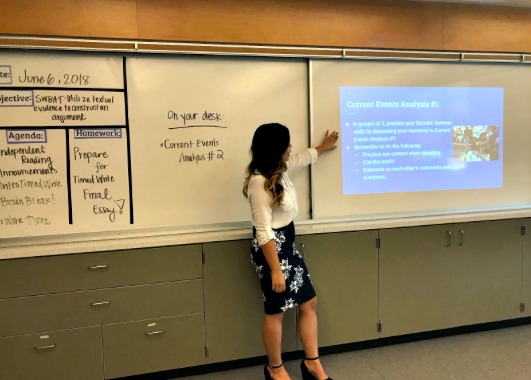It’s ignorant to think that students are able to leave their identities and lived experiences at the door. A true educator takes those experiences and uses them as assets within the classroom, demonstrating to students that they are valid. If we are able to get students to believe that their life experiences are a source for academic material, we bridge the connection between academics and personal lives, thereby facilitating deeper learning and understanding of the materials we teach. These principles have weighed heavy on my mind as I wrap up my first year in the classroom. I have the privilege of teaching 10th grade English in Richmond, California through a curriculum that is deeply rooted in discussions of race and identity. Every unit aims to walk my sophomores through a different aspect of their identity and the ways in which those around them view it. When I say this is a privilege, it is not an understatement.
As a Latinx educator teaching at a school that is also predominantly Latinx, I have a lot of shared background and experiences with my students. This identity has made it easy for students to be able to connect with me and for me to build relationships with their class cohorts, as well as individually. However, it’s also important to acknowledge that my identity within the classroom deeply impacts my interactions and relationships with my students.
With everything occurring in the political landscape of the country right now, it’s very challenging for me to leave out my biases and preconceptions when discussing the issues about race and identity in the curriculum with my students, I often get positive feedback for being “real” about the issues occurring, but it also leaves me wondering how well I’m doing at presenting both sides of the conversations. Throughout this year, my classes and I have been engaging in discussions around current events and the impact of laws on our communities. As their teacher, I present my students with the information and background on the laws and events impacting their lives and then give them a vehicle to explore their opinions and reactions to it.
In a recent conversation about the role of civil disobedience in the government, students openly shared their worries around issues of immigration, police brutality, and other civic issues. There have been times throughout the year where my students have presented valid questions that I have had to admit to not having answers to. Most of them rooted around the blatant racial discrimination being experienced by communities of color within the United States. It’s heartbreaking to teach mini history lessons about the civil rights era and make the unfortunate connection to the fact that similar instances are occurring within the United States, times haven’t changed much. However, I am continually inspired by the hopeful and action-oriented approach my students take to these issues. Most of my students will be eligible to vote in the next election, and I am hopeful about the change they will bring within their generation.
Daniela Felix
Latest posts by Daniela Felix (see all)
- The Importance of Mid Year Data for Teachers, Students, and Families - December 18, 2019
- Las Familias Deben Participar en la Mejora de los Resultados de las Pruebas SBAC de California - December 10, 2019
- La Guia de los Aprendices de Inglés de California es un Recurso Útil para los Maestros - December 4, 2019
- California’s English Learner Roadmap Is a Helpful Resource for Teachers - December 2, 2019
- Families Need To Be Involved in Improving California’s SBAC Test Results - November 27, 2019

